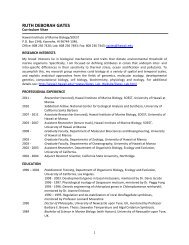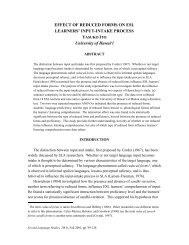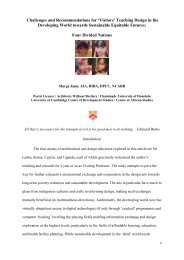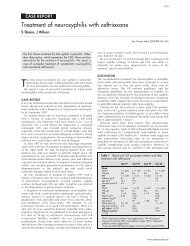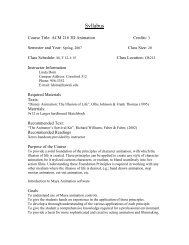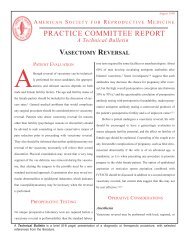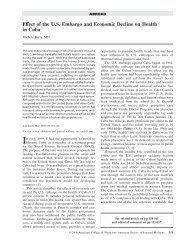Tying and Untying the Trouser-Cord - University of Hawaii
Tying and Untying the Trouser-Cord - University of Hawaii
Tying and Untying the Trouser-Cord - University of Hawaii
Create successful ePaper yourself
Turn your PDF publications into a flip-book with our unique Google optimized e-Paper software.
62 J. W. Frembgen<br />
in <strong>the</strong> nuptial night where usually two complete strangers meet for <strong>the</strong> first time. It is<br />
said that in many cases <strong>the</strong> bride is brutally raped. At least sometimes, for <strong>the</strong> first<br />
period <strong>of</strong> marriage, young couples are provided with an enclosed private space, such<br />
as, for example, <strong>the</strong> summer room on <strong>the</strong> upper storey <strong>of</strong> <strong>the</strong> house in Hunza<br />
(Karakoram/Nor<strong>the</strong>rn Pakistan).<br />
For <strong>the</strong> sexual act, <strong>the</strong> trouser-cord is untied, but <strong>the</strong> trousers are mostly not taken<br />
<strong>of</strong>f. Social notions <strong>of</strong> sharm, that is feelings <strong>of</strong> shyness, modesty, <strong>and</strong> shame, are<br />
strong <strong>and</strong> man <strong>and</strong> wife usually do not completely undress. Complete nakedness is<br />
generally held in abhorrence following <strong>the</strong> well-known hadith reported by Ibn Majah:<br />
‘Nudity has been denounced to <strong>the</strong> extent that a husb<strong>and</strong> <strong>and</strong> wife, even while having<br />
intercourse, have been asked to observe <strong>the</strong> etiquette <strong>of</strong> satr <strong>and</strong> not to be completely<br />
naked like donkeys.’ Likewise sexual wishes <strong>and</strong> expectations are not verbally<br />
expressed. However, sexuality in marriage is viewed positively by <strong>the</strong> Qur’an <strong>and</strong> a<br />
hadith says: ‘The best wife is <strong>the</strong> one who protects her chastity <strong>and</strong> is sensually fond<br />
<strong>of</strong> her husb<strong>and</strong>.’ Normative statements vary among different schools <strong>of</strong> religious law<br />
as to whe<strong>the</strong>r a married couple may look at each o<strong>the</strong>r’s body during <strong>the</strong> sexual act or<br />
not (cf. Bousquet 1966, pp. 104 /6, 184; Omar 1989, p. 54). Never<strong>the</strong>less, <strong>the</strong> model<br />
<strong>of</strong> <strong>the</strong> Prophet is clear in <strong>the</strong> saying: ‘Aisha stated that <strong>the</strong> Prophet never looked at her<br />
private parts nor did she look at his.’<br />
Although in a number <strong>of</strong> cases, for instance in <strong>the</strong> Punjab, among <strong>the</strong> Pakhtun<br />
(l<strong>and</strong>ai-poetry) <strong>and</strong> in Rajasthan, women’s oral traditions invoke a rich imagination<br />
<strong>of</strong> romantic, sexually playful, <strong>and</strong> exuberant women, this does not represent a direct<br />
key for <strong>the</strong> underst<strong>and</strong>ing <strong>of</strong> actual sexual behaviour. To a certain extent, <strong>the</strong>se songs<br />
<strong>and</strong> stories ‘about flirtation, enticement, erotic bites, exciting entanglements’ (Gold<br />
1994, p. 40) with an illicit lover, which are performed on prescribed ritual occasions,<br />
might reflect experiences from adulterous liaisons; however, generally speaking, <strong>the</strong>y<br />
have to be interpreted as a ‘culture <strong>of</strong> resistance’ or as ‘rituals <strong>of</strong> rebellion’ in<br />
Gluckman’s terms (Werbner n.d., p. 3).<br />
In real life, eroticism can develop only in a more refined atmosphere: it depends on<br />
<strong>the</strong> couple if <strong>the</strong>y prefer complete darkness or if a c<strong>and</strong>le or oil-lamp is allowed to<br />
burn, if <strong>the</strong>y perfume <strong>the</strong>ir bodies before <strong>the</strong> act, take some sweets toge<strong>the</strong>r <strong>and</strong> so<br />
on. Ei<strong>the</strong>r out <strong>of</strong> modesty or to tease or excite her husb<strong>and</strong> (or lover) a woman may<br />
tie her trouser-cord with a number <strong>of</strong> knots, which he would have to untie. Sublime<br />
forms <strong>of</strong> promise <strong>and</strong> luring, withholding, <strong>and</strong> teasing in such foreplay situations<br />
work as a powerful stimuli; in this way <strong>the</strong> h<strong>and</strong>ling <strong>of</strong> <strong>the</strong> izar-b<strong>and</strong> is something<br />
like a capricious detour to fulfil erotic desire. Similar to <strong>the</strong> use <strong>of</strong> <strong>the</strong> European<br />
‘chastity belt’, which originated in <strong>the</strong> fifteenth century in Florence, it obviously<br />
enhances male lust to open something apparently well locked up. In any case, <strong>the</strong><br />
nala represents an obstacle that has to be overcome, a boundary that has to be<br />
crossed before being naked <strong>and</strong> ready for intercourse. Usually <strong>the</strong> man unties <strong>the</strong><br />
string; only rarely, in a very relaxed <strong>and</strong> trusting relationship, <strong>the</strong> woman may open<br />
<strong>the</strong> knots herself. This active versus passive/shy behaviour also reflects gender<br />
differences in a sexual ‘temperament’ culturally determined by Islam.



